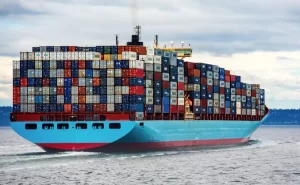The definition of a containership class is a function of draft and related capacity in TEU. Since the beginning of containerization in the mid-1950s, containerships undertook six general waves of changes, each representing new generations of containerships:
A. Early containerships
The first generation of containerships was composed of modified bulk vessels or tankers that could transport up to 1,000 TEUs. The first containership, the “Ideal-X” was a converted World War II T2 tanker. At the beginning of the 1960s, the container was a transport technology being tested and gradually deployed, and reconverting existing ships proved to be of lower costs and less risky. These ships were carrying onboard cranes since most port terminals were not equipped to handle containers. They were also relatively slow, with speeds of about 18 to 20 knots, and could only carry containers on the converted decks and not in their bellyhold.
Once the container began to be massively adopted at the beginning of the 1970s, the construction of the first fully cellular containerships (FCC; second generation) entirely dedicated to handling containers started. The first cellular containerships, called the C7 class, were introduced in 1968. All containerships are composed of cells lodging containers in stacks of different heights depending on the ship’s capacity. Cellular containership also offers the advantage of using the whole ship to stack containers, including below deck. Usually, an extra two containers in width can be carried above deck than below deck. Cranes were removed from the ship design so that more containers could be carried (cranes remain today on some specialized containerships). The ability of ports to handle cellular containerships ceased to be a major concern with the setting of specialized container terminals worldwide. Cellular containerships were also much faster with speeds of 20-24 knots, which would become the speed of reference in containerized shipping.
B. Panamax
During the 1980s, economies of scale rapidly pushed for the construction of larger containerships. The larger the number of containers being carried the lower the costs per TEU. The process became a virtuous circle, compounding larger volumes and lower costs, which significantly helped the diffusion of the container and its use for international trade. The size limit of the Panama Canal, which came to be known as the Panamax standard, was achieved in 1985 with a capacity of about 4,000 TEUs.
Once this limit was achieved, a decade passed before a new generation of larger containerships was designed. Simultaneously, Panamax container ship designs were evolving to take maximum advantage of the canal’s limitation in beam width. These ships came to be known as Panamax Max. The original dimensions of the Panama Canal, built by the US Army Corps of Engineers, are similar to the dimensions of the US Inland Waterways locks, resulting in narrow and long ship design.
C. Post Panamax I and II
Going beyond Panamax was perceived as a risk in terms of the configuration of shipping networks, additional handling infrastructure as well as draft limitations at ports. The APL C10 containership class, with a capacity of 4,500 TEUs, was introduced in 1988 and was the first containership class to exceed the 32.2 m width limit of the Panama Canal. By 1996, full-fledged Post Panamax containerships were introduced with capacities reaching 6,600 TEUs. The first Post-Panamax ship classes were not much longer than the Panamax class, but wider, making them more efficient. A ship above the Panamax size requires a substantial amount of cargo to be used profitably along a service loop and by the late 1990s, the rapid growth of global trade made such a ship class a marketable proposition.
Once the Panamax threshold was breached, ship size quickly increased with capacities reaching 8,000 TEUs (Post Panamax II; “Sovereign Class”). Post Panamax containerships triggered an infrastructure challenge for many ports since they require deeper drafts (at least 43 feet) and highly efficient, but costly, portainers (ship-to-shore cranes) having wider reaches. Draft constraints became a factor placing pressure on ports to dredge to accommodate post-Panamax containerships.
D. Very Large Containership (VLCS)
By 2006, the third generation of post-Panamax containerships came online when Maersk shipping line introduced a ship class with a capacity in the range of 11,000 to 14,500 TEUs; the Emma Maersk (E Class). They were dubbed Very Large Containerships since they are bigger than the specifications of the expanded Panama Canal. This new class was particularly demanding for port infrastructures as their draught exceeded 15 meters and a width of 22 containers across. The number of ports capable of handling VLCS is limited, particularly ports in river deltas that can face access channels constraints.
E. New-Panamax, or Neo-Panamax (NPX)
This refers to ships designed to fit exactly in the locks of the expanded Panama Canal, which opened in June 2016. These ships have a capacity of about 12,500 TEU, but there are several configurations of Neo-Panamax ships in terms of length (17 to 22 bays) and width (19 or 20 containers across). Like its Panamax counterparts, Neo-Panamax ships are likely to define a specific ship class able to service the Americas and the Caribbean, either from Europe or Asia. Neo-Panamax ships are likely to become the new standard in port infrastructure design for decades to come.
F. Ultra Large Containership (ULCV)
A further extension of the post-Panamax design led to the introduction of the Ultra Large Containership class of 18,000 TEUs and above in 2013 (named ‘Triple E’ by Maersk). This class was further expanded, and by 2017, ships above 20,000 TEUs started to be delivered.
An additional expansion in 2019 introduced ships of 24 containers across and with 24 bays, dubbed Megamax-24 (MGX-24). The ULCS/Megamax-24 is getting close to the technical limits that the Suez Canal can accommodate, beyond which the commercial relevance declines substantially. It remains to be seen which routes and ports these ships would service, but they are limited mostly to routes between Asia and Europe. There are larger ship designs on the drawing boards, such as the “Malacca Max” class, that could carry about 27,000-30,000 TEU, but they are not expected to be constructed until there are sufficient volumes on the limited routes these ships could service.
Future Prospects
Containership speeds have peaked to an average of 20 to 25 knots, and it is unlikely that speeds will increase due to energy consumption; many shipping lines are opting for slow steaming to cope with higher bunker fuel prices (when there are market spikes) and overcapacity (to have more ships in a slower service). The deployment of a class of fast containerships has remained on the drawing boards because the speed advantages they would confer would not compensate for the much higher shipping costs. Supply chains have been synchronized with container shipping speeds, and the setting of landbridges, such as the Eurasian landbridge, offers a competitive service for time-sensitive cargoes.
Each subsequent generation of containership faces a shrinking number of harbors able to handle them and places pressures on port infrastructure and equipment. Maritime shipping companies are incited to use the largest containerships possible on their shipping routes since they benefit from economies of scale. However, ports and inland transportation systems must provide substantial capital investment if they expect to accommodate larger containerships. Thus, operational limitations are to deploy ships bigger than 8,000 TEU in terms of ports of call and the required infrastructure to provide an acceptable loading and unloading throughput. Also, large containership deployments require a substantial amount of cargo to be commercially feasible, such as adequate service frequency. Containerships in the range of 5,500 to 6,500 TEU appear to be the most flexible in terms of the ports they can access and the market they can service since using larger ships require fewer port calls. Therefore, limits to economies of scale in container shipping are much more limited by commercial attributes than by technical constraints.
shippingposition
Kindly like us on Facebook/twitter














